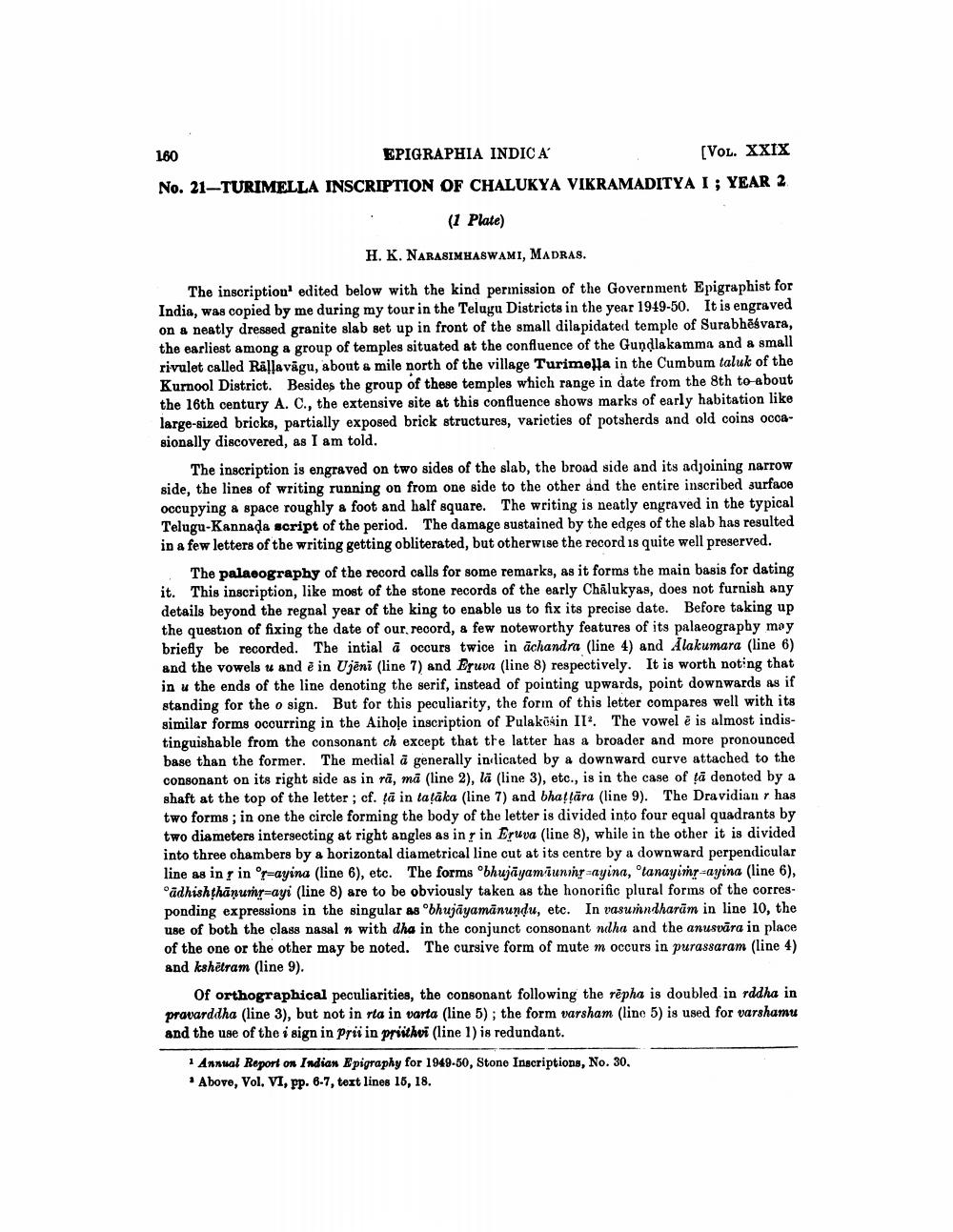________________
160
EPIGRAPHIA INDICA
[VOL. XXIX
No. 21-TURIMELLA INSCRIPTION OF CHALUKYA VIKRAMADITYA I; YEAR 2
(1 Plate)
H. K. NARASIMHASWAMI, MADRAS.
The inscription' edited below with the kind permission of the Government Epigraphist for India, was copied by me during my tour in the Telugu Districts in the year 1949-50. It is engraved on a neatly dressed granite slab set up in front of the small dilapidated temple of Surabhēsvara, the earliest among a group of temples situated at the confluence of the Gundlakamma and a small rivulet called Rallavägu, about a mile north of the village Turimella in the Cumbum taluk of the Kurnool District. Besides the group of these temples which range in date from the 8th to about the 16th century A. C., the extensive site at this confluence shows marks of early habitation like large-sized bricks, partially exposed brick structures, varieties of potsherds and old coins occasionally discovered, as I am told.
The inscription is engraved on two sides of the slab, the broad side and its adjoining narrow side, the lines of writing running on from one side to the other and the entire inscribed surface occupying a space roughly a foot and half square. The writing is neatly engraved in the typical Telugu-Kannada script of the period. The damage sustained by the edges of the slab has resulted in a few letters of the writing getting obliterated, but otherwise the record 18 quite well preserved.
The palaeography of the record calls for some remarks, as it forms the main basis for dating it. This inscription, like most of the stone records of the early Chalukyas, does not furnish any details beyond the regnal year of the king to enable us to fix its precise date. Before taking up the question of fixing the date of our record, a few noteworthy features of its palaeography may briefly be recorded. The intial a occurs twice in achandra (line 4) and Alakumara (line 6) and the vowels u and è in Ujeni (line 7) and Eruva (line 8) respectively. It is worth noting that in u the ends of the line denoting the serif, instead of pointing upwards, point downwards as if standing for the o sign. But for this peculiarity, the form of this letter compares well with its similar forms occurring in the Aihole inscription of Pulakosin II. The vowel è is almost indistinguishable from the consonant ch except that the latter has a broader and more pronounced base than the former. The medial a generally indicated by a downward curve attached to the consonant on its right side as in ra, mā (line 2), lä (line 3), etc., is in the case of ta denoted by a shaft at the top of the letter; cf. ta in tataka (line 7) and bhattara (line 9). The Dravidian r has two forms; in one the circle forming the body of the letter is divided into four equal quadrants by two diameters intersecting at right angles as in r in Eruva (line 8), while in the other it is divided into three chambers by a horizontal diametrical line cut at its centre by a downward perpendicular line as in r in rayina (line 6), etc. The forms bhujāyamāunir ayina, tanayimṛ-ayina (line 6), adhishthanumṛ-ayi (line 8) are to be obviously taken as the honorific plural forms of the corresponding expressions in the singular as bhujayamānundu, etc. In vasundharam in line 10, the use of both the class nasal n with dha in the conjunct consonant ndha and the anusvāra in place of the one or the other may be noted. The cursive form of mute m occurs in purassaram (line 4) and kshetram (line 9).
Of orthographical peculiarities, the consonant following the repha is doubled in rddha in pravarddha (line 3), but not in rta in varta (line 5); the form varsham (line 5) is used for varshamu and the use of the i sign in prii in priithvi (line 1) is redundant.
1 Annual Report on Indian Epigraphy for 1949-50, Stone Inscriptions, No. 30. Above, Vol. VI, pp. 6-7, text lines 15, 18.




